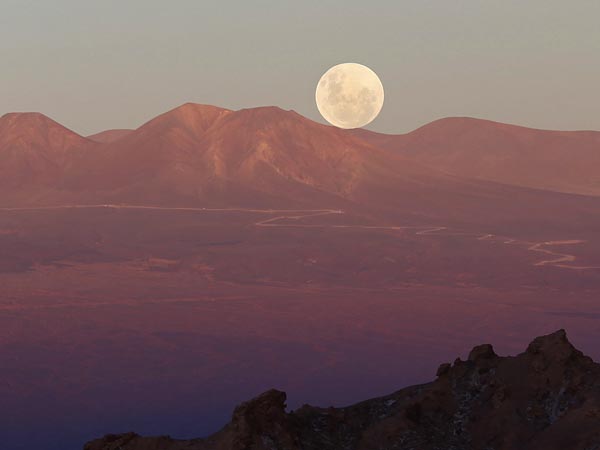Solstice Supermoon Fills Sky This Weekend
This moon, seen from San Pedro de Atacama, Chile, was the largest of 2012. This year's supermoon will occur on June 23, and appear 8 percent larger and 17 percent brighter.
Editor's note: Share your best #supermoon photos with us and our editors may include one in a NationalGeographic.com gallery.
This weekend, skywatchers looking up at the full moon may sense it's a bit more striking than usual—and they won't be imagining it.
On June 23, the moon will be at its closest distance to Earth for 2013 while in its full phase. As a result, it will appear 8 percent larger and 17 percent brighter than usual—an event widely known as a supermoon.
And making it a bit more special, thanks to coincidental timing, this supermoon will be coming on the heels of the June solstice, which takes place only two days before.
Armchair astronomers can also catch the sky show virtually via a live high-definition webcast of the supermoon through SLOOH telescopes in the Canary Islands, off the coast of Africa, starting at 9 p.m. EDT or 6 p.m. PDT on June 23.
The monthly full moon always looks like a big disk, but because its orbit around the Earth is egg-shaped, there are times in the lunar cycle when the moon is at its shortest distance from Earth (called perigee) and times when the moon is at its farthest distance from Earth (called apogee).
Likewise, because the size of the moon's orbit varies slightly, each month's perigee is not always the same distance from Earth.
Two years ago, the so-called supermoon was the closest it's been in two decades—only 356,575 kilometers from Earth.
For this weekend's perigee, the moon will be a tad farther from us at 356,991 kilometers. That's a bit closer than the typical 364,000 kilometers distance, and is set to occur on June 23 at 7:09 a.m. EDT. (The official full moon phase occurs at 7:32 a.m. EDT.)
"The exact moment when the moon is at perigee, it will be overhead in the southern Pacific Ocean," said Anthony Cook, an astronomical observer at Los Angeles's Griffith Observatory. "The western portion of the Americas will see this at sunrise/moonset, while the eastern portion of Asia/Australia will see it at sunset/moonrise."
Super-Effects?
While some are calling it a supermoon, the astronomical community prefers to use the term "perigee full moon."
And they're not exactly rare, since the alignment between the full moon phase with perigee occurs every year, said Adler Planetarium astronomer Mark Hammergen.
But next year's show on August 10, 2014, might be more specular than this one. That's because it's expected to be even closer—clocking in at just 356,896 kilometers from Earth, said Hammergren.
As for a supermoon coinciding with the solstice, that's more unusual.
"This kind of celestial geometry repeats roughly every 14 years," said Hammergren.
And if you thought a supermoon might bring out "super-effects" on Earth, think again. There is no scientific evidence for any connection between a supermoon and natural disasters.
It is, however, well known that tides are highest during new and full moons -- which means if there is a storm surge during a new or full moon, then unusually high coastal flooding may occur.
"When the full or new moon occurs near perigee, there is a slightly stronger effect on the tides," said Hammergren. "There have been coastal floods associated with storms hitting near spring tide at the time of perigee."
Snapping the Supermoon
For photo hounds, the most picturesque moments will occur twice: first, in the minutes after local sunset on Saturday, and then before sunrise on Sunday morning as the full moon rises or sets at the local horizon.
"I recommend shooting from a mountainside, hillside, or a roof so that the horizon will be pleasing," said Cook. "With a little planning, a distant landmark can add to the scene, possibly silhouetted by the moon."
In order to make the moon large enough to look interesting, you can use a telephoto lens ranging between 100mm and 2000mm, depending on how you want the picture to look.
"By choosing a foreground carefully, the composition can be interesting for a wide choice of lenses," he added.
But Cook said that while the buzz surrounding the supermoon is nice, skywatchers shouldn't have exaggerated expectations.
"This [phenomena] is based on a [distance] that we know because of computers, not because it creates a unique and [particularly] easily perceptible effect," said Cook. "What I would encourage people to do is observe, photograph, and make notes about full moons throughout the year and discover what factors make one more impressive than another."
Andrew Fazekas
for National Geographic
Published June 22, 2013












